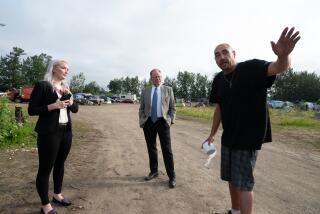Into the Wild: 3 hikers rescued near scene of fatal Alaska adventure
- Share via
SEATTLE — For years, it has proved an irresistible lure for intrepid travelers around the world: the battered, weed-grown bus where hiker Chris McCandless died after trying, and failing, to survive in the great Alaskan wilderness.
McCandless’ demise out in the big lonely was chronicled in the book and movie, “Into the Wild.” This week three German travelers were rescued by helicopter after attempting to repeat the young dreamer’s trip—running afoul of the same raging river that kept McCandless from hiking to safety.
“They decided they were just worn out and exhausted. They’d already had one mishap and they weren’t going to have another,” Alaska State Troopers spokeswoman Megan Peters said.
A hiker who’d met the three men on the trail alerted troopers that the three had set out for the famous bus, about 20 miles from the end of Stampede Road near the town of Healy. But as of Monday, three days later, they had not returned.
A helicopter crew launched a search and found them within about 10 minutes, all “in fair condition, but hungry and wet,” according to the troopers’ dispatch.
Peters said the trio had apparently reached the bus. But on the way back, one of them fell and lost a lot of his gear while crossing the swollen Teklanika River—the same river that lay between McCandless and safety in 1992.
The hikers continued on to the second crossing on the Savage River, but with that waterway running high, too, “they just decided it was not a good idea to cross it,” Peters said.
The three hikers, Florian Gerner, 21, Roger Karl, 20, and Eric Schlegel, 19, were examined and cleared by medics in Healy.
The story of “Into the Wild” has become a touchstone for people around the world, both those who yearn to repeat a young urban man’s dangerous foray into some of the nation’s last true wilderness, and those who have dismissed McCandless as a clueless adventurer who went into hazardous territory dangerously unprepared.
“He was not a hero, he was a spoiled brat who didn’t even bother to learn about the land he was going into. His hubris killed him,” one commenter wrote after the Alaska Dispatch posted the story about the German hikers.
But Erik Halfacre, an Anchorage designer and videographer who operates a website and video with advice for adventurers inclined to make their way out to the bus, said more than 100 people a year successfully make the journey. Others, however, must be rescued in places all over Alaska after attempting much more dangerous travels.
“It’s interesting to me that people get that upset about the idea that anybody might want to go see the bus where Chris lived,” he said.
“The hike is really not that dangerous and the number of rescues on the trail are not that disproportionate compared to other areas of the state. But people get upset because they don’t like Chris,” he said. “They think he went out totally unprepared, and he didn’t have enough respect, which may be partially true. But there’s been a lot of other people that’s happened to that they haven’t raked over the coals quite so hard. But those people didn’t get a movie made about them.”
The bus, an old International Harvester left as a wilderness shelter by a construction company in the 1960s, rests south of Denali National Park. McCandless, 24, a native of El Segundo, was a devotee of Henry David Thoreau and Jack London and had hoped to embark on a period of solitary contemplation.
He took little food with him, though, was unskilled in finding sustenance in the wilderness and may have fallen ill. He was found in the bus four months after he set out, weighing only 67 pounds, likely dead of starvation.
“S.O.S. I need your help. I am injured, near death, and too weak to hike out,” said a note he left on the bus, found by a hunter. “I am all alone, this is no joke. In the name of God, please remain to save me. I am out collecting berries close by and shall return this evening. Thank you, Chris McCandless.”
The lure of the bus had previously claimed another victim: 29-year-old Claire Jane Ackermann of Switzerland, drowned in 2010 while trying to cross the Teklanika River near the bus.
There have been frequent calls to remove the bus and end the need for further rescues. Those appeals started up again this week.
“Some would say that bus needs to be hauled off with lots of publicity so no one else ventures there and dies,” one woman commented to the Dispatch. “I, however, say it should be left there. It is just another device through which the Universe culls the herd.”
Peters said there are no plans to remove it.
“It’s a matter of who it belongs to, who’s going to pay for it to be moved. It’s just there,” she said. “We’ve got mountains that people get lost and hurt on and we don’t move them.”
Another idea gaining support is to construct a safe crossing over the Teklanika. McCandless’ sister, Carine McCandless, and members of Ackermann’s family are looking into rebuilding a cable crossing, disabled by vandals, that once traversed the river on the trail to the bus.
“They’d like to either construct a road bridge or a cable trolley or some means for walkers to cross the river again,” Halfacre said. “It probably costs a few thousand dollars every time somebody goes out there and gets rescued. But at the same time, the number of people who fly to Alaska going out to that bus, they need lodging, they need food, that brings much more money in.
“And if they were to construct a bridge or reconstruct this cable car, you’d never have to do these rescues again.”
ALSO:
Spelling bee is a national cynosure
Blake Sheldon to aid tornado victims, more severe weather ahead
Missing man appears as news crew reports his disappearance
More to Read
Sign up for Essential California
The most important California stories and recommendations in your inbox every morning.
You may occasionally receive promotional content from the Los Angeles Times.










